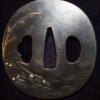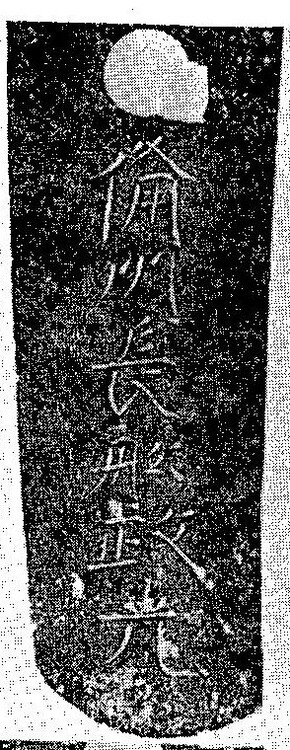-
Posts
497 -
Joined
-
Last visited
-
Days Won
1
Everything posted by Veli
-

I need help learning how to translate meis.. and this katana
Veli replied to Eziodjinn's topic in Translation Assistance
You might find this useful... http://www.nihontomessageboard.com/nmb/viewtopic.php?f=15&t=4110 BR, Veli -
Personally, I find the small hakobore like in Eric's picture#1 very easy to accept. I'd rather have a hakobore than excessive loss of metal during polishing. Extensive loss of Kawagane, on the other hand, makes me shudder... Veli
-
Chris, I agree in case the hagiri is caused by the quenching stress etc. But if it is battle-inflicted, it does not necessarily indicate the lack of skill of the smith. BR, Veli
-
Great topic, Paul! What about the following cases: 1) A hagiri "repaired" by suriage, so that the location of the hagiri has been moved from above to below the hamachi, i.e. the blade now has a nakago-giri . [i would accept this at least if the hagiri is below the new mekugi-ana.] 2) A blade with a sharp bend but no traces of hagiri/shinae. [i would not buy this kind of a blade.] 3) A blade with partial kakedashi where 50 % (or 90%) of the width of the habuchi has been lost. [i would personally tolerate maybe 20% but no more.] Recently blades with hagiri have been sold by highly respected dealers, the existence of the fault clearly indicated. These blades seem to fetch reasonably high prices. [i wouldn't buy them, nor would I blame those who do, since hagiri is in my opinion a smaller fault than poor workmanship.] BR, Veli
-
Well, stopping corrosion (red rust) is theoretically easy, but expensive and cumbersome in practice: Inert gas storage. Rust needs both oxygen and moisture to form. Remove one or both, and the rusting stops. I guess the equipment for storing a few blades would cost at least 2000 USD. Furthermore, the blades could only be inerted without saya or tsuka, since inerting would dry out and crack any wooden parts. The system could consist e.g. of a large diameter glass tube with removable steel flanges with O-ring seals on both ends, equipped with inlet and outlet gas valves, as well as an inert gas source (nitrogen bottle + regulator + flow meter + tubing). The blades should rest on inorganic soft supports. This would be a major project and investment. In addition, the lady in the house might object... BR, Veli
-
I would not recommend using acetone for cleaning. Industrial grade acetone is full of contaminants. If you let a drop of acetone dry on a clean glass surface, you end up with an ugly stain of solid residue. High-purity ethanol should be OK when used in a dry climate. BR, Veli
-
Roy, I would be delighted to learn more about Lesley Stewart; What kind of training and background does he have? Any info on the web? BR, Veli
-
Looks like Kanehira saku: 兼平作 BR, Veli
-
Attached a scan from Fujishiro. My personal unlearned opinion is that it is a close match. I still think the blade is very tired, but it does have some beauty left. If the owner is happy with it, I do not object by any means. What a magnificent piece it was before loosing the kawagane. Veli
-
Too late... Would have said Osafune Motomitsu... Veli
-
Well, I can see its past beauty through tiredness and kakedashi... BR, Veli
-
There is a signature example of Kawachi no Kami Nagakuni (the one who worked in Higo) in Fujishiro's. If you post a photo of the mei, it can be compared with the authentic example. Veli
-
Hi! Second to fourth kanji on the ura probably read "Hishu Kumamoto" 肥州 熊本, which is a town in Higo (nowadays Kumamoto) province. BR, Veli
-
I thought this was a fun video clip. Actually you can buy this kind of a samurai for 5333€. Yari not included, I suppose :D http://www.iltasanomat.fi/videot/ulkomaat/1784004 Veli
-
Well, I am not an expert on photography... I normally do only minor postprocessing: cropping, maybe very slight brightness tuning, resizing... and that is all. Veli
-
What a beautiful hada! I am asking to learn, not to suggest anything: How much of the O-itame is due to metal removal by polishes (the number of which seems to be smaller than in most blades of this age) or has it been visible already when the blade was new? BR, Veli
-

Translation help needed for Hisatsugu in Toko Taikan book
Veli replied to Justin Grant's topic in Translation Assistance
Hi Justin! I think the smith values read 700 man yen = 7 000,000 yen and 1000 man yen = 10 000,000 yen If I read correctly, neither of these smiths worked in the Muromachi period. On the left it reads Toku-ji (1306-1307) Bizen, on the right Ko-an (1278-1288) Bitchu BR, Veli -
Ian, Yes, I agree with you that producing such fakes would not really make sense due to tremendous logistical problems. Veli
-
Hello Ian and Stephen! The reasons why I do not think this is Japanese: - Never seen that kind of sugata (shape) on a Japanese blade - The curvature looks uneven, it seems to have undulations - Constant mihaba (width) - The shoulder on the mune - Kissaki (tip) shape is not right - There is nothing that speaks of high quality - It comes from China These are my personal opinions only! However, should this blade be proved to be a genuine Japanese nagamaki, I'll donate 50 USD to NMB as repentance. Brian, take note! BR, Veli
-
Hello Stephen! I am sorry to say but in my opinion, based on the shape, quality of workmanship and the country of origin, this is definitely not Japanese. I hope your interest in Japanese swords will prevail and your next blade will be a genuine and beautiful one. Please, study hard, and success shall follow :D BR, Veli
-
I had a machine-made type 95 NCO katana a couple of years ago. It did have very similar kissaki, bo-hi, sugata, serial numbering... Something like hamon (that shouldn't be there) is barely visible in the pictures ... Veli
-
Hi Todd! Let us say that finding a katana by a Hawley 50 points/Fujishiro Chu-Jo saku level smith in you gun safe is a lucky incident indeed. That kind of swords are very decent collector pieces, though not really treasures. Defining the authenticity of the kanji is a tricky thing, and I am not an expert. But let's see the second to last kanji, "Kane". Compare the lowest strokes of that kanji to the Fujishiro example, and you see that they are positioned differently and of different length. On the other hand, the first kanji looks like a photocopy of that in Fujishiro's... Somehow, the chisel strokes are confident, and their smooth curves resemble closely those in the reference. Thus my comment that the signature is by someone of the same lineage as the smith who signed the reference. BUT I AM ONLY A BEGINNER, PLEASE DO NOT FORM YOUR FINAL OPINION BASED ON MY HUMBLE EFFORTS. A good idea is to show this to an experienced collector. Do visit Curran if you have the chance. Submitting to shinsa is the only sure way to know whether the signature is authentic. Very nice find, in any case! BR, Veli
-
Hello Todd, My apologies, seems that I made a mistake. I rechecked the smith and seems that he is not HAW KAN2068, but probably one of HAW KAN2027, KAN2029, KAN2030, who also sometimes signed with exactly the same title and name. An oshigata of the 5th generation (HAW 2030) was found in Fujishiro's: He is a 50 points smith from Iwashiro province, active 1688-1711. Please see attachment. I leave it to more experienced NMB members to comment whether the signature looks authentic. (My personal opinion that is not reliable: It is close to the reference, but not a perfect match. Might be different generation, but same lineage.) In any case this is a katana worthy of care, appreciation and preservation! As for the price, you can look at the AOI art wakizashi. http://www.aoi-art.com/sword/wakizashi/09327.htmlPlease remember, however, that papers are guaranteed and it is in a very good polish and condition. May also be different generation. BR, Veli
-
Hello There! I think you got the two kanji right (3rd and 4th, that is)! It seems to be 近江大掾藤原兼定 Omi Daijo Fujiwara Kanesada, Hawley KAN2068, 15 points, Shinto, Owari Shimosaka line. The kanji strokes look confident and good to my unexperienced eyes. If you compare with this, you can see the similarity yourself: http://www.aoi-art.com/sword/wakizashi/image/09327-3.jpg It would be nice to see pictures of the hamon, sugata and boshi! Oh, by the way, we are all required to sign our posts with out real names, so that we can address each other properly and also learn to know each other! BR, Veli



